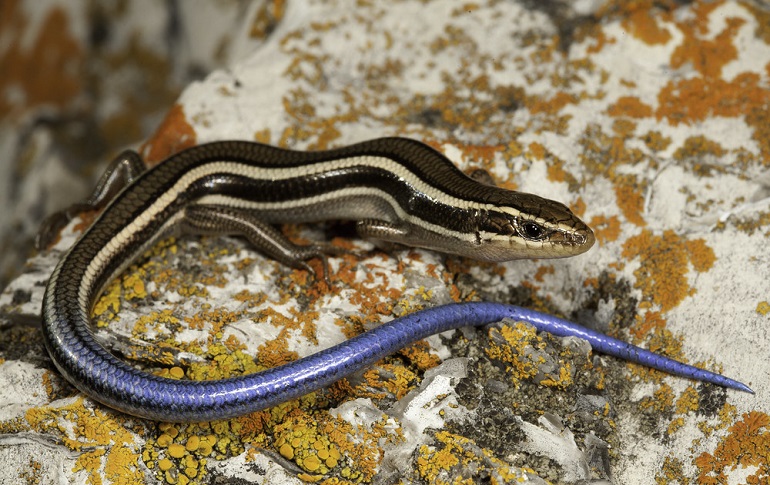With often brightly colored, sleek bodies and a similar looking appearance to that of a snake, although technically a lizard, this is the skink.
Found in backyards and the wild throughout most parts of the world, skinks are a great addition to any environment with their lightning-fast reflexes to help keep insect populations in check.
And in addition, some species make great pets too! But what about these shy creatures make people reluctant to have them around?
Are skinks dangerous? No. Are skinks poisonous? No. Are skinks poisonous to dogs and cats? No, and can skinks inject venom? No.
But unfortunately, these often timid and harmless creatures, due in part no doubt to their resemblance to a snake, are often mistaken as being dangerous and poisonous.
In this article, we look at skinks and uncover more about this fascinating species.
Are Skinks Poisonous to Humans, Dogs, and Cats?
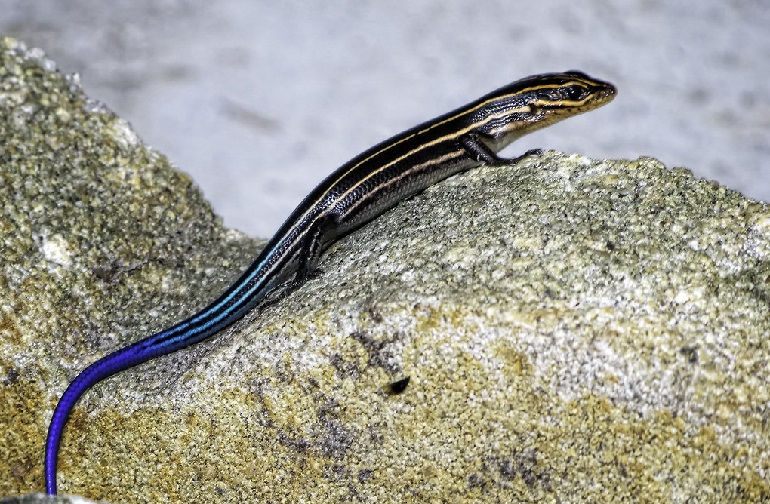
Contrary to popular belief, skinks are not poisonous or venomous but are capable of biting. In fact, the confusion surrounding this lizard species stems from many species sharing similar names, such as the Blue-tailed Skink.
Technically speaking, this species of common skink found throughout North America is actually the American five-lined skink. This species of skink should not be confused with the Blue Tailed Skink from Australia’s Christmas Island, which has garnered the unfortunate reputation of being poisonous, which is not true.
In fact, the biggest concern, aside from their bites which do not cause severe damage, is that some skinks have bacteria and carry salmonella and parasites, which can cause infection in humans if they come into contact with open wounds when handling them.
And although there are no scientific studies to suggest that skinks are poisonous to cats or dogs, there is a slim chance that both animal species can suffer gastrointestinal upsets if they ingest a skink.
Again there is the concern of potential salmonella poisoning in both cats and dogs if ingested and liver flukes which are parasitic worms that affect cats more than dogs.
Skink Bites
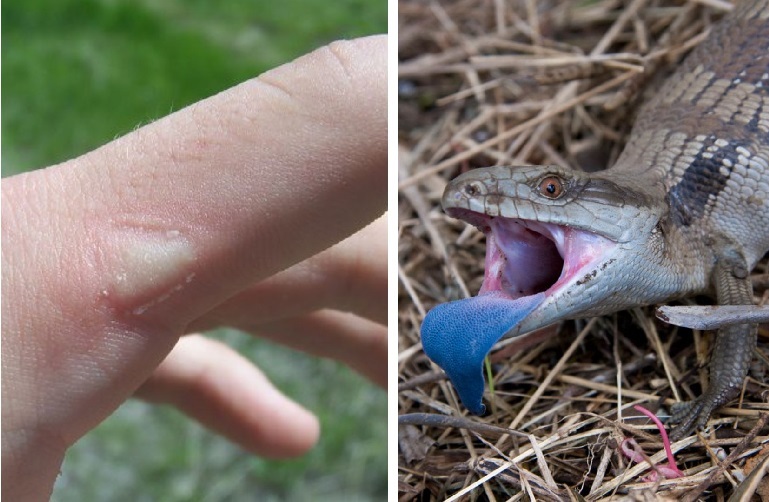
Skinks can bite in self-defense or if they perceive a person as a threat.
Generally speaking, skinks are not aggressive; they have about 40 small sharp teeth (pleurodont teeth) fused to their jawbone, which is strong enough to clasp against the skin and is really the only weapon they have.
However, skink bites are often shallow, light, and pain-free as their teeth are small and designed more to capture their prey when hunting or feeding.
As such, with a skink bite, you will not typically have to seek medical attention straight away, although it is always advisable to wash your hands thoroughly after any handling of a skink as it could carry bacteria.
Typically a pet skink can give some signals of a bite before it happens. These include:
Hissing
In fact, most lizards do this as a warning as they don’t have many defense mechanisms to warn off or deter predators or perceived threats.
Flattening Their Body
When threatened, skinks may hiss and flatten out their body in the hopes of appearing longer and more menacing.
Opening Their Mouth
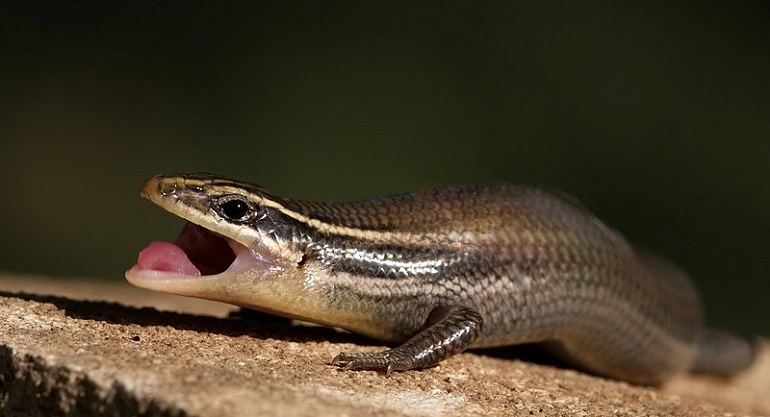
Skinks may also open their mouths in warning and defense and to threaten their adversaries.
Puffing Up
Just as they can flatten their body, skinks can also puff up to make themselves appear larger than they are as a warning to back off.
Flicking Tongues
Interestingly enough, researchers have suggested that skinks restrict the flicking or showing off their full tongues until the final stages of an attack when it feels the most threatened.
What Do Skinks Look Like?
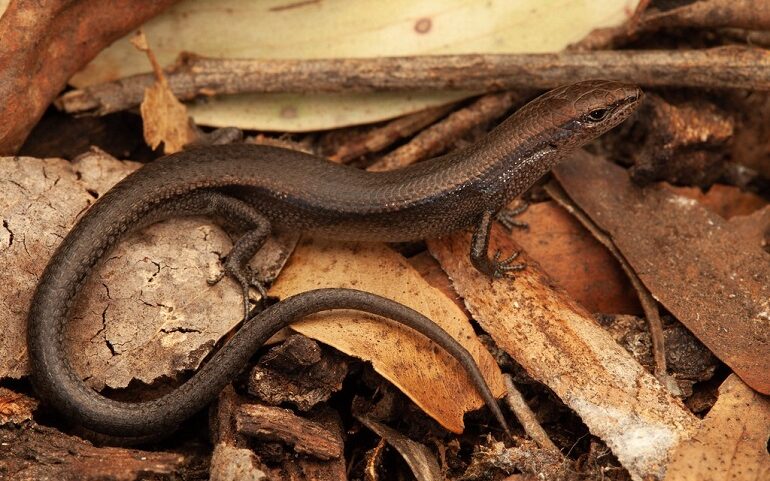
Typically skinks share some common features with lizards, such as external ear openings, eyelids, and four legs. But unlike true lizards, most skink species have smaller legs and no pronounced neck.
In fact, with their long slender bodies and the way they move, skinks look more like snakes than lizards. And having said that, some species of skink do not have limbs, such as the Fitzsimmons legless skink and the coastal legless skink found in South Africa.
A skink’s head which is slightly off the ground and pointed upwards, is covered by bony scales on the skin’s surface that overlap all the way down its body. And interestingly, skinks have full eyelids, which enables them to keep their eyes moist and round pupils for daytime activity.
Most skinks range in size from just a few inches, with snout-to-vent lengths averaging around five inches. But there are larger skink species, such as the Solomon Islands skink, which can grow up to three feet long, although half of this length is made up by its tail.
While in contrast, the pygmy blue-tongued skink is the smallest and rarest of the skink species measuring just four inches long.
Additionally, skinks vary widely in coloration and patterns, with some presenting with bland coloring that blends in with their background, while others have stripes or spots.
Interestingly, some skink species change color during the breeding season to alert others to their availability, such as the male five-lined skink whose head turns orange-reddish.
Where Are the Skinks Found?
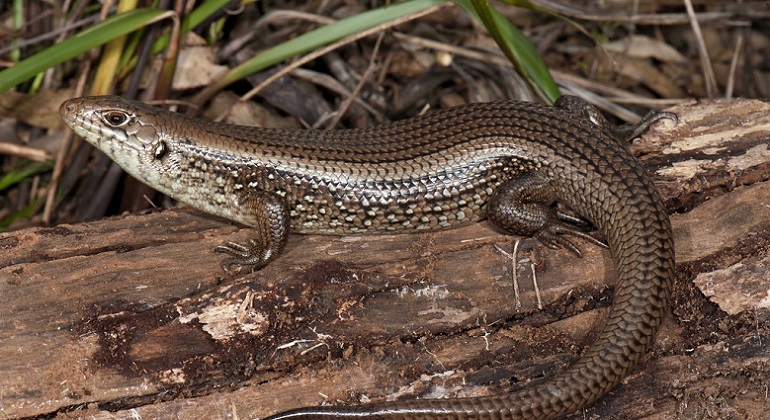
With over 1,500 species of skinks in other subfamilies, it’s no wonder these little reptiles have the widest diversity in their habitat. In fact, they can be found in different ecosystems worldwide, barring sub-arctic and arctic regions.
Their natural areas in the wild can include agricultural areas, wetlands, deserts, cities, mountainous regions, rainforests, woodlands, and so many more.
These secretive and shy ground dwellers typically prefer hiding places in habitats where they can burrow in the sand. And are especially diverse in Southeast Asia, South America, Africa, Australia, and the temperate regions of North America.
Interestingly some species of skinks are tree dwellers, and others are semiaquatic.
What Do the Skinks Eat?
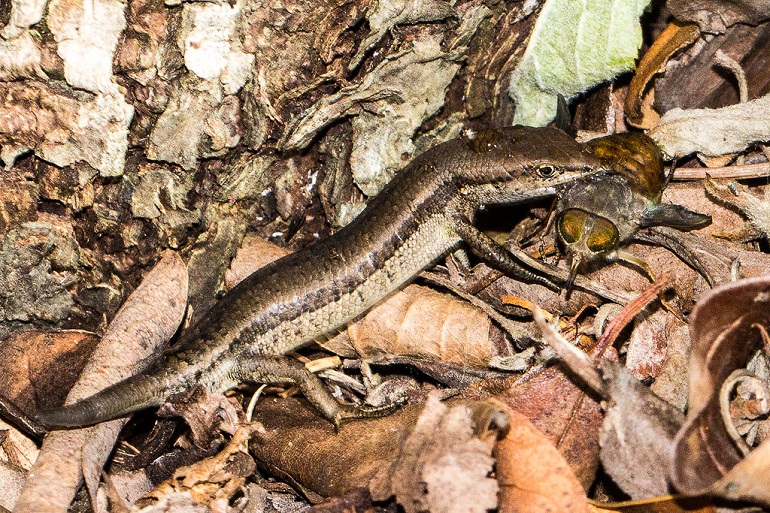
Generally speaking, skinks are carnivores, and in particular, insectivores in that they eat both insects and plants. Their typical diet can include crickets, grasshoppers, caterpillars, flies, and beetles.
But some skink species are known to eat small rodents, other small lizards, earthworms, slugs, snails, and moths.
In fact, those species favored as pets are omnivores and have a diet that consists of 60 percent vegetables or fruit and 40 percent of meat (rodents or insects). As such, the different skink species utilizes various food sources according to the region and habitat they are found in.
Interesting Facts About Skinks
Did you know that some species of skink, such as the green-blooded skink and Parker’s green tree skink, have green blood due to the buildup of bile products in their body?
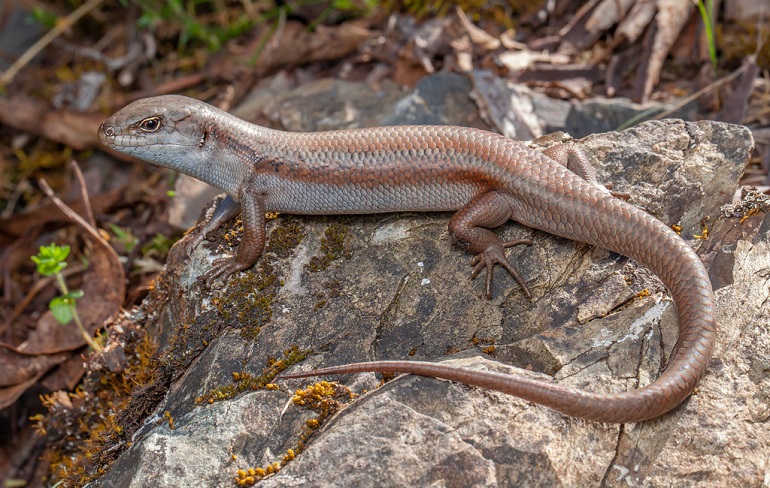
Here are some more interesting lesser-known facts about skinks.
Skinks Can Shed Their Tails
Skinks can shed their tails when threatened and grow a new one later. This self-defense mechanism lures a predator to go after the still-wiggling dropped tail, enabling the skink to escape safely.
Bright Colors Do Not Equal Dangerous
Unlike many other creatures in the animal kingdom whose bright colors indicate how poisonous they are, all skinks, despite sharing the same bright skin features, are not poisonous or venomous.
Skinks Are Solitary Creatures
Just like frogs, skinks only get together when it’s time to mate. In fact, adult females lay up to a dozen eggs in a nest under rocks and logs and then leave them for the baby skinks to hatch a month later and fend for themselves.
Types of Skinks
From tree-dwelling skinks, such as the tree crevice skink, to semi-aquatic skinks, such as the mangrove skink, which can remain submerged in water for minutes at a time, there are just too many species to mention.
But what is interesting is that some of these skink species have adapted over time, such as the Percival lance skink, which is limbless and a sand swimmer with fused eyelids.
In fact, some of the well-known types due to them making great pets include the following:
Blue Tongue Skinks
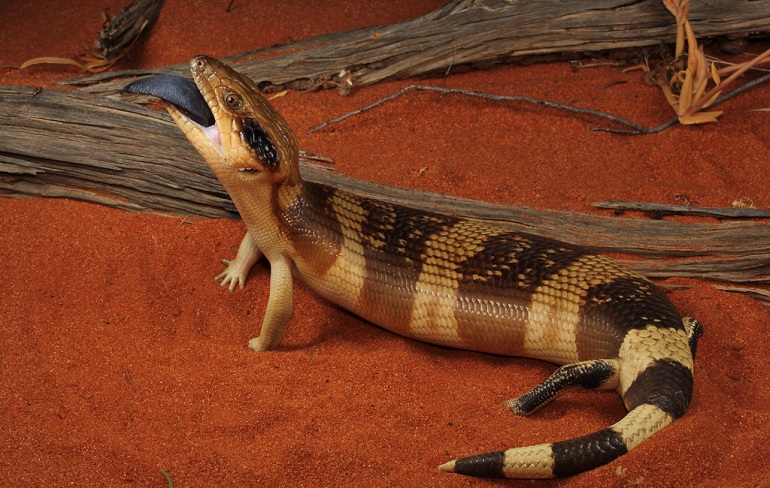
All blue tongue skinks species are found on mainland Australia, New Guinea, and various Indonesian islands.
Distinguishable by their distinct blue tongue, these skinks are known as beginner pets due to their gentle, quiet, and docile ways and are easily tamed.
Leopard Skinks
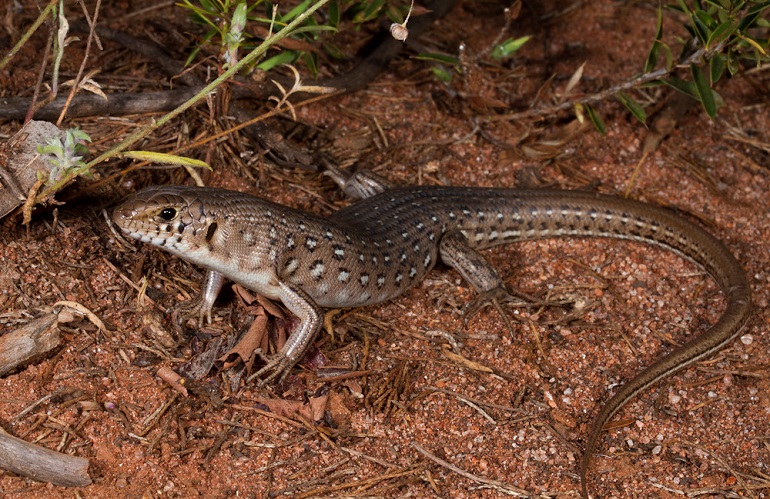
Found in central and western Australia, Leopard skinks are so named for their distinctive leopard-like markings on their bodies.
Again, this species of skink has a placid and docile nature and will allow children to hold them when tamed.
Fire Skinks
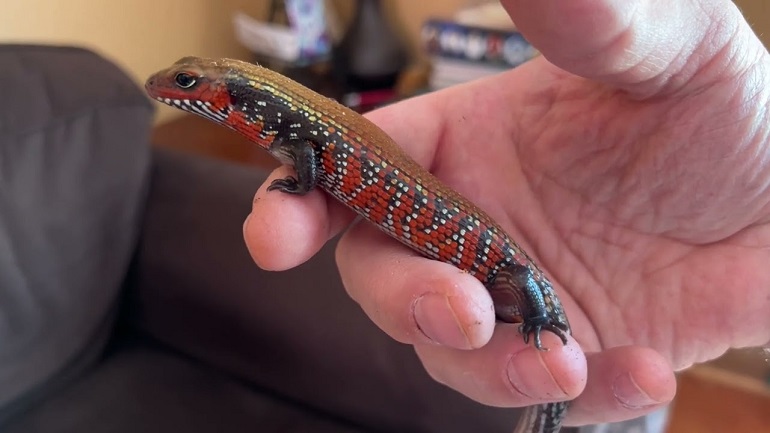
Considered one of the most beautiful species of skinks, the Fire skink is renowned for its vivid and bright colors.
These skinks are indigenous to the tropical rainforests of Western Africa and possess a mild temperament.
Schneider’s Skinks
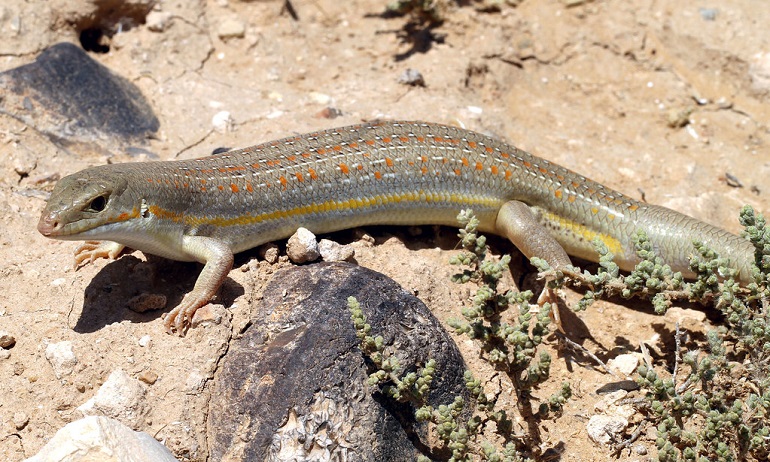
Active and curious, these skinks are social creatures and enjoy having the company of one or two other Schneider skinks in their terrarium with them.
These skinks are found in Central and Western Asia and North Africa, possess a mellow personality and enjoy being held.
Monkey-tailed Skinks
Also known as the Solomon Island Skink, Prehensile Tailed Skink, or Giant Skink, they are the largest of the skink species and popular pets for reptile lovers.
This species of skink native to the Solomon Islands has thick long sharp claws to assist with climbing and a tail that can wrap around tree branches.
Blue Tailed Skinks
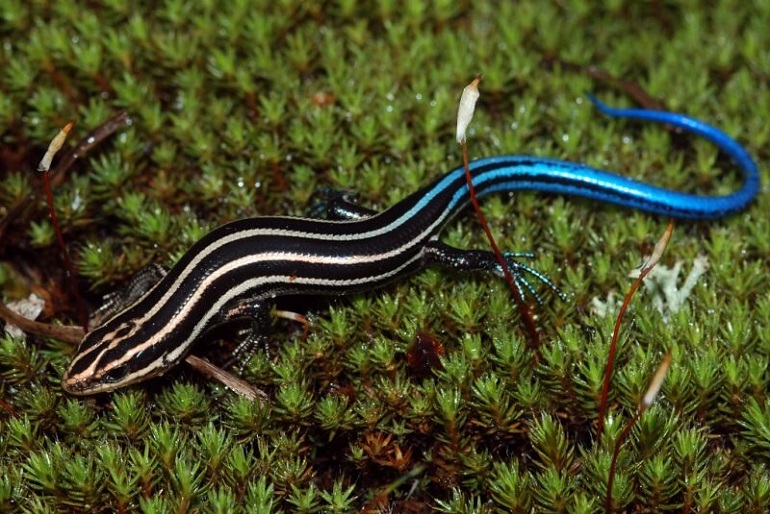
The two most common blue-tailed skink species are found in the Eastern United States and Australia’s Christmas Island.
These are active skinks who, if captive-bred, are calm and docile, while wild-caught, they are more likely to be aggressive. This skink species prefers not to be handled, so it is more for display only.
Red-eyed Crocodile Skinks
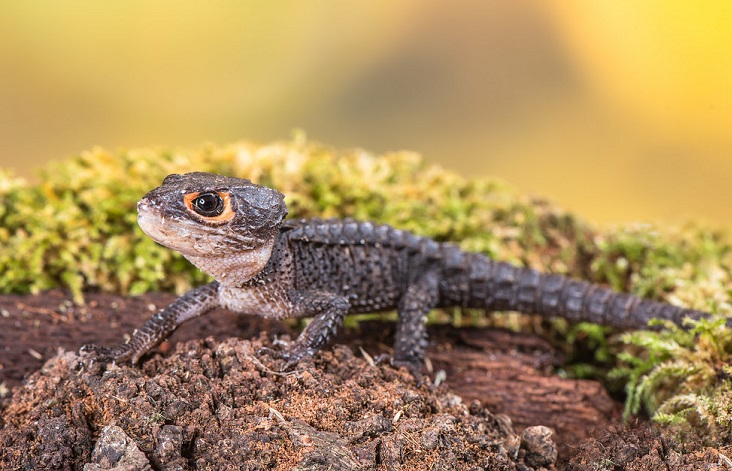
Found in New Guinea, red-eyed crocodile skinks are a smaller skink species and are often kept as exotic pets by reptile enthusiasts. In fact, they are one of the few species of skink that vocalize when distressed.
Although not aggressive, they are easily startled, tend to freeze when handled, and even play dead. Again, this species of skink is more for show than handling.
Ocellated Skinks
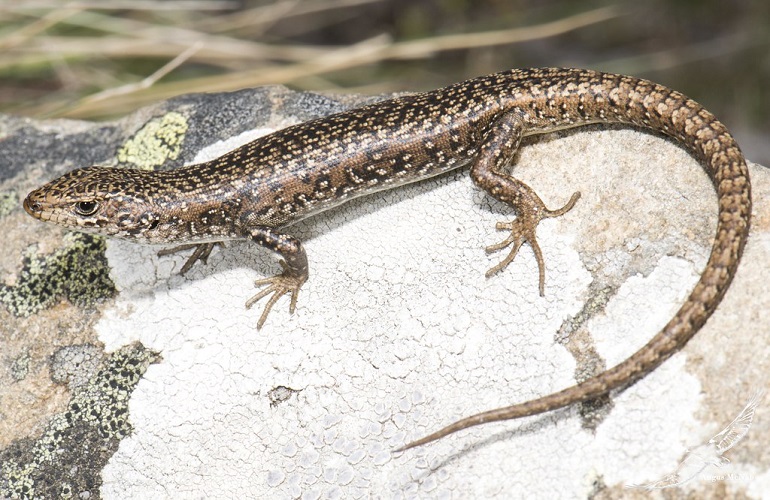
Also known as the ocellated bronze skink or eyed skink, this species, despite being native to the Mediterranean coast, is now widespread and an established invasive species in France and the US.
Despite being quite hardy with curious personalities, these skinks are not very handleable.
Common Garden Skinks
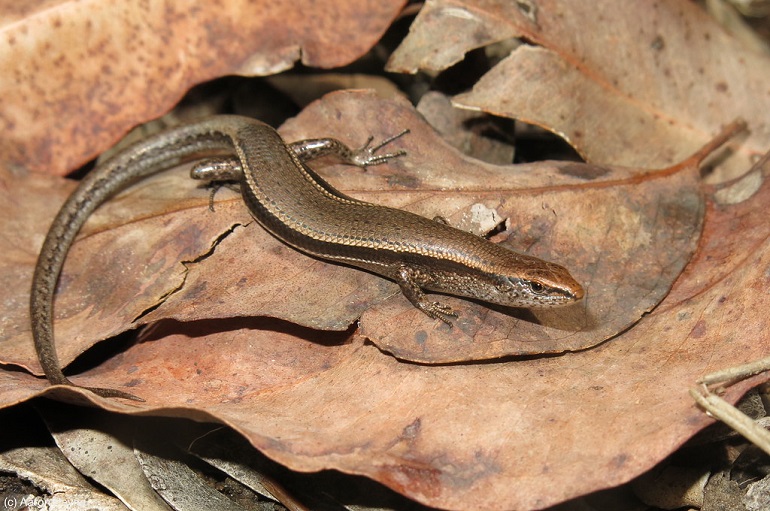
Found in Australia, this little skink is also known as the grass skink, pale-flecked garden sun skin, and penny lizard. This skink species is very docile, with even wild common garden skinks allowing themselves to be picked up.
Are Skinks Good Pets?
Skinks make entertaining pets as they are neither poisonous nor venomous. But an important factor to remember when taking on a pet skink is that some species make better reptile pets than others, as they are calmer and allow for easier handling.
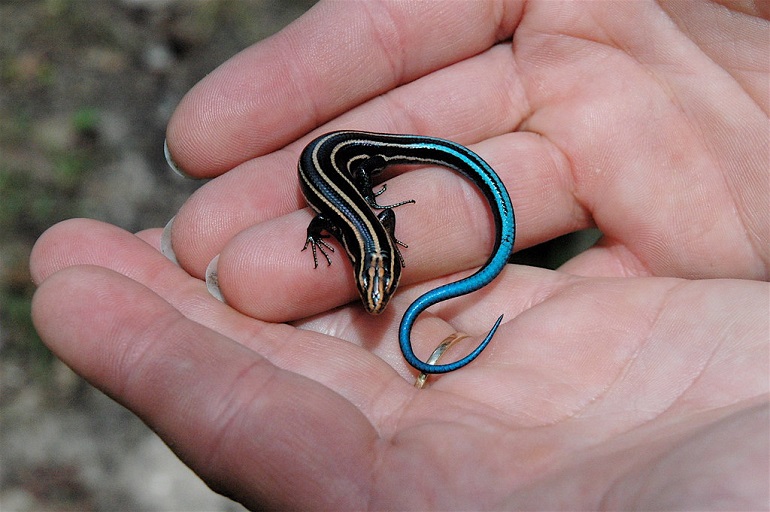
A Blue-tongued pet skink, for instance, is said to be the easiest to handle as it is slow-moving and quickly won over with treats. While a blue-tailed pet skink, on the other hand, will fight against being handled.
Additionally, some skinks require larger and more complex habitats than others to accommodate their larger sizes. In fact, most people opt for a terrarium that allows for the space, humidity, and temperature that their pet skink species requires.
Skinks, as such, are generally considered low-maintenance pets who require feeding once or twice a week and clean water every day. What is essential, however, is to keep a skink’s habitat clean, as they require a clean environment in which to thrive.
Why Do Skinks Bite?
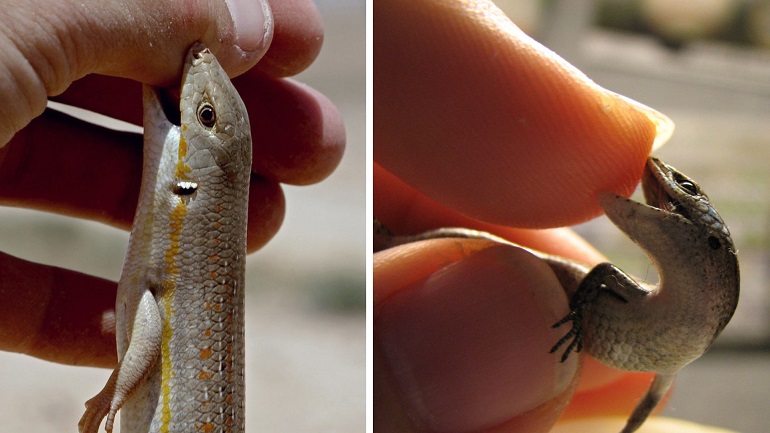
Skinks rarely bite, and if they do so, it’s usually a self-defense mechanism. Some of the reasons for skinks bites are:
- The animal does not want to be handled or was overhandled
- The skink fees threatened, or
- The animal thinks a person’s fingers are food when too close to its mouth, and its instinct is to bite them.
How to Avoid Skink Bites?
Like any other animals, skinks must be treated with care and respect. Avoid unnecessarily provoking a skink and always observe its behavior for an impending bite, such as when it flicks its tongue or hisses.
Be cautious and avoid picking the animal up if it seems wary or stressed, as it may startle and reflexively bite.
Conclusion
Skinks play a vital role in the ecosystems they inhabit in the wild by consuming insects and sometimes pests while serving as a food source for a broader range of predators.
And while some species can make great pets for reptile lovers, before taking on one of these creatures into captivity, it is advisable to research your skink species first.
As if you are looking for a skink that is more of a companion and doesn’t mind being handled, you certainly don’t want to end up with the Red-eyed Crocodile Skink.
But most importantly, what kind of commitment and care can you provide for the animal? For while some skinks only live two to three years, other skink species can live up to 20 years, so they become a long-term commitment as a pet.
And lastly, remember these small reptiles are not poisonous!!


